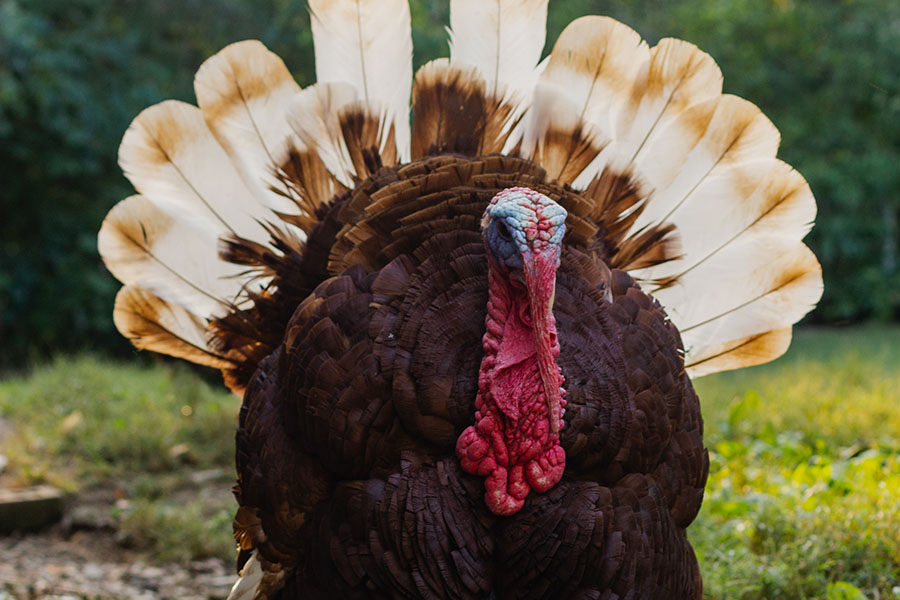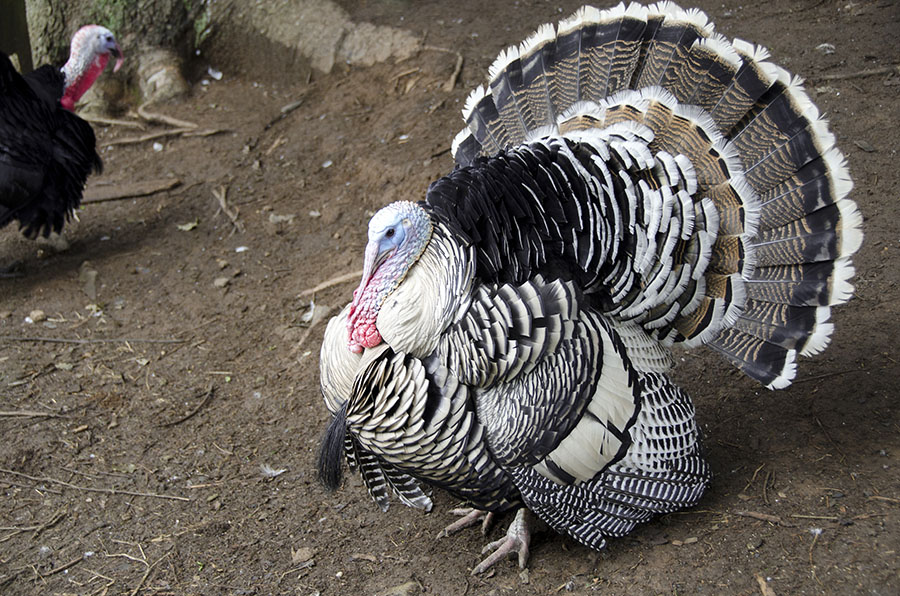Home > Lifestyle > Food For Thought > Top 9 Turkey Breeds Found on Farms Across the United States
Top 9 Turkey Breeds Found on Farms Across the United States
There are dozens of chicken, duck and goose breeds out there. You might even be able to name a few of the most common varieties of each. But how familiar are you with the various turkey breeds? While they may not be quite as prolific as our other feathery friends, there are several turkey varieties raised for meat in the United States. Keep reading to learn about nine common turkey breeds found on American poultry farms and Thanksgiving tables.

1. Broad Breasted White
When it comes to domestic turkeys in America, the Broad Breasted White is the most common. Intentionally developed with white feathers to avoid discoloration under the skin, these birds are notorious for producing substantial amounts of breast and thigh meat, which understandably makes them a popular choice in the commercial market.
2. Black
As you might imagine, the Black turkey is easily spotted by its black plumage. Their feathers are metallic and shiny, and they often have a green gloss that can be spotted when the sun hits them just right. These birds descend from wild turkeys brought to America by Spanish explorers in the 1500s, and they are a common variety found in several European countries.

3. Bourbon Reds
When you envision the classic Thanksgiving turkey illustration, a Bourbon Red is probably the bird that comes to mind. Beautifully red with white tail feathers, these birds are one of the most popular heritage breeds because of their full flavor and tender, mouthwatering meat. They originated in Kentucky and can weigh anywhere from 12 to 23 pounds.
See more: How to Host Thanksgiving: Do’s and Don’ts
4. Standard Bronze
Some describe the Standard Bronze as stately and imposing. It could have something to do with the fact that these are among the largest of the heritage turkey breeds. Before they’re even fully mature, these birds can measure an impressive 25 pounds. A cross between wild turkeys and domesticated turkeys from Europe, these are some of the most commonly raised commercial meat birds.

5. Royal Palm
Docile and attractive, Royal Palm turkeys stand out among the crowd thanks to their white feathers rimmed in black. Unlike many other varieties of turkey, these weren’t bred for quick growth to get them from farm to table in a short window of time – and they’re on the small side. Consequently, a lot of people consider them ornamental. But they range from 10 to 20 pounds, which makes them a good size for the average family wanting to raise their own meat birds.
6. White Holland
White Holland turkeys come from – you guessed it – Holland. The modern variety is a mix of these original white European birds and native North American ones. They’re on the larger side, weighing anywhere from 20 to 30 pounds. White Hollands were among the most common breeds raised for meat in the 1800s but actually find themselves on the threatened species list today.

7. Narragansett
Named after Narragansett Bay in Rhode Island, these domestic birds are primarily raised for meat production but occasionally as a hobby because of their beautiful plumage and dramatic coloration. They aren’t as popular as some of the other breeds across the country but can often be found in New England and in the mid-Atlantic states. Considered peaceful and calm, they make excellent mothers, produce a good number of eggs and mature more quickly than some other breeds, making them a good candidate for family farms.
8. Midget White
Remarkably similar to the Broad Breasted White turkey, these commercial birds were developed in Massachusetts in the early 1960s by crossing Broad Breasted White Turkeys with Royal Palms. They range in size from 12 to 20 pounds and were originally bred to offer smaller birds to the commercial market. Unfortunately, this size never took off on a larger scale, so they didn’t gain the popularity breeders originally hoped. Nevertheless, they offer a good amount of breast meat and can lay an average of 60 to 80 large eggs per year.
See more: How Turkeys Go From Diestel Family Ranch to Your Thanksgiving Table
9. Blue Slate Turkeys
One of the most attractive heritage breeds is the Blue Slate turkey. They’re a dark meat bird with particularly delicious drumstick meat, and many describe their taste as flavorful, moist and firm. They originated in Mexico more than 2,000 years ago but weren’t recognized by the American Poultry Association until 1874. Unlike some commercial varieties, Blue Slates can reproduce naturally, making them a good option for small farms and backyard breeders.




[…] all know the turkey is the star of the show when Thanksgiving rolls around. But that doesn’t mean the side dishes are […]
Are there Black Turkey farms who skin their birds and sell their feathers for fly tying and/or crafts?
Craig
[…] https://farmflavor.com/lifestyle/top-9-turkey-breeds-found-on-farms-across-the-united-states/ […]
[…] https://www.eatingwell.com/article/7935512/is-turkey-bacon-healthy/ Top 9 Turkey Breeds Found on Farms Across the United States […]
[…] Read More […]
[…] Red Turkeys are both safe and humane to eat. They can live and breed naturally for years, unlike commercial turkey breeds, which are artificially inseminated and frequently die young of injuries or illnesses. How long […]
[…] idea to try something new with them, as well as try the recipe itself. There are several different turkey breeds that can lay eggs that taste different to different people. Some Beltsville white egg layers are […]
Is there a way to tell what breed your grocery store turkey comes from? Butterball? Publix?
They are broad breasted white turkeys
Most likely the white broad breasted.
[…] in popularity as more people learn about them. Bourbon red turkeys nest on the ground, like most other turkey breeds. They prefer to nest in areas with thick vegetation, which provides them with camouflage and […]
[…] Beginner’s Guide to Raising Heritage-Breed Turkeys is intended for those who are just getting started with the hobby. For several years, I had raised […]
[…] using antibiotics, GMOs, or synthetic chemicals. Cook’s Illustrated recommended heritage-breed turkey varieties from Elmwood Stock Farm during a recent taste test. There have been no other organic turkey farms […]
[…] Red is a domestic turkey breed named for its distinctive reddish skin and its native Bourbon County, Kentucky. This country is […]
Just wanted to point out that Turkeys originated in the Americas. They were domesticated by peoples in the Americas (the Maya for one) and that’s where Europeans got their domesticated breeds from originally. The way the article reads seems to suggest that Turkeys came from Europe, but they are not native to Europe.
[…] flavorful and tender compared to commercially raised turkeys. Understanding the unique qualities of different turkey breeds empowers you to make an informed choice that aligns with your desired […]